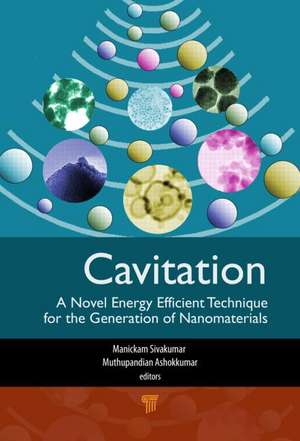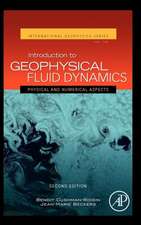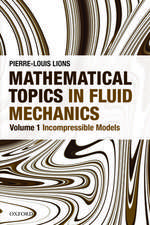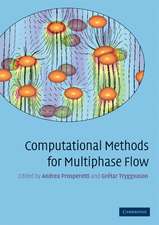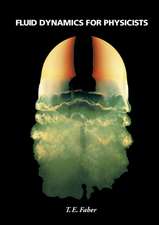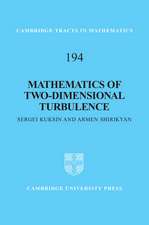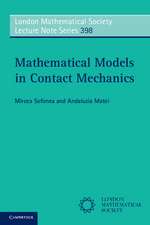Cavitation: A Novel Energy-Efficient Technique for the Generation of Nanomaterials
Editat de Sivakumar Manickam, Muthupandian Ashokkumaren Limba Engleză Hardback – 5 aug 2014
A wide range of nanomaterials have been developed in the past decade using cavitation or coupling cavitation with other techniques such as microwave, photochemistry, and electrochemistry, resulting in nanomaterials with unique morphologies, reduced size, narrow size distribution, and innumerous advantages. While a few currently available books deal with the fundamental aspects of cavitation and sonochemistry, this book is devoted specifically to the technologically important nanomaterials obtained by cavitation.
Preț: 903.19 lei
Preț vechi: 1101.45 lei
-18% Nou
Puncte Express: 1355
Preț estimativ în valută:
172.85€ • 187.69$ • 145.19£
172.85€ • 187.69$ • 145.19£
Carte tipărită la comandă
Livrare economică 22 aprilie-06 mai
Preluare comenzi: 021 569.72.76
Specificații
ISBN-13: 9789814411547
ISBN-10: 981441154X
Pagini: 454
Ilustrații: 164 black & white illustrations, 16 colour illustrations
Dimensiuni: 152 x 229 x 28 mm
Greutate: 0.79 kg
Ediția:New.
Editura: Jenny Stanford Publishing
Colecția Jenny Stanford Publishing
ISBN-10: 981441154X
Pagini: 454
Ilustrații: 164 black & white illustrations, 16 colour illustrations
Dimensiuni: 152 x 229 x 28 mm
Greutate: 0.79 kg
Ediția:New.
Editura: Jenny Stanford Publishing
Colecția Jenny Stanford Publishing
Public țintă
Academic and PostgraduateCuprins
Development of Multifunctional Nanomaterials by Cavitation. Generation of Size-, Structure-, and Shape-Controlled Metal Nanoparticles Using Cavitation. Sonochemical Synthesis of Noble Mono- and Bimetallic Nanoparticles for Catalytic Applications. Ultrasound-Assisted Synthesis of Metal Oxide Nanomaterials. Synthesis of Nanomaterials Using Hydrodynamic Cavitation. Sonoelectrochemical Synthesis of Nanomaterials. Preparation of Nanomaterials Under Combined Ultrasound/Microwave Irradiation. Ultrasound-Assisted Preparation of Nano- and Micro-Polymeric Materials for the Encapsulation of Bioactive Agents. Innovative Inorganic Nanoparticles with Antimicrobial Properties Attached to Textiles by Sonochemistry. Ultrasonic Processing for Synthesis of Nanocomposite via in situ Emulsion Polymerization and Their Applications. Controlled Sonochemical Fabrication of Mesoporous Surfaces and Metal Sponges. Numerical Simulations of Nucleation and Aggregation of BaTiO3 Nanocrystals Under Ultrasound. Ultrasonics and Sonochemistry: Some Issues and Future Perspectives.
Notă biografică
Sivakumar Manickam is a professor at the Department of Chemical and Environmental Engineering, University of Nottingham, Malaysia Campus. He specializes in process engineering of nanomaterials, especially nanopharmaceuticals, and has worked in the area of ultrasound and hydrodynamic cavitation since 1997. He also heads the Manufacturing and Industrial Processes Research Division and is the coordinator of the Centre for Nanotechnology and Advanced Materials. Prof. Manickam is also the recipient of the JSPS fellowship, Japan; the Fellow of Higher Education Academy, UK; and member of the Institute of Nanotechnology (IoN), UK. His research group focuses on the process development of cavitation-based reactors toward technologically important nanomaterials.
Muthupandian Ashokkumar is a professor at the School of Chemistry, University of Melbourne, Australia. He is a physical chemist who specializes in sonochemistry. He has developed a number of novel techniques to characterize acoustic cavitation bubbles and has made major contributions of applied sonochemistry to the food and dairy industry. Prof. Ashokkumar’s recent research involves the ultrasonic synthesis of functional nano- and biomaterials, including protein microspheres that can be used in diagnostic and therapeutic medicine. He is a Fellow of the Royal Australian Chemical Institute and recipient of the Grimwade Prize in Industrial Chemistry.
Muthupandian Ashokkumar is a professor at the School of Chemistry, University of Melbourne, Australia. He is a physical chemist who specializes in sonochemistry. He has developed a number of novel techniques to characterize acoustic cavitation bubbles and has made major contributions of applied sonochemistry to the food and dairy industry. Prof. Ashokkumar’s recent research involves the ultrasonic synthesis of functional nano- and biomaterials, including protein microspheres that can be used in diagnostic and therapeutic medicine. He is a Fellow of the Royal Australian Chemical Institute and recipient of the Grimwade Prize in Industrial Chemistry.
Recenzii
"This book is about new ways of making nanomaterials using cavitation effects. The new book offers a multi-author perspective on new developments and research directions in this field. Topics covered here are really new and innovative, and hence will really inspire scientists and students."
Prof. Mahito Atobe, Yokohama National University, Japan
"This book summarizes the most recent achievements in the sonochemical synthesis of nanomaterials. Among a variety of approaches, the utilization of acoustic cavitation provides rapid and environmentally friendly route to access nanostructured materials with controlled properties. The combination of power ultrasound with other reagent-free techniques largely discussed in this book will undoubtedly attract readers’ attention."
Dr. Sergey Nikitenko, CNRS, ICSM, France
Prof. Mahito Atobe, Yokohama National University, Japan
"This book summarizes the most recent achievements in the sonochemical synthesis of nanomaterials. Among a variety of approaches, the utilization of acoustic cavitation provides rapid and environmentally friendly route to access nanostructured materials with controlled properties. The combination of power ultrasound with other reagent-free techniques largely discussed in this book will undoubtedly attract readers’ attention."
Dr. Sergey Nikitenko, CNRS, ICSM, France
Descriere
The past decade has witnessed the development of a wide range of nanomaterials using cavitation. While a few currently available books deal with the fundamental aspects of cavitation and sonochemistry, there is no book devoted specifically to the technologically important nanomaterials obtained by cavitation. This was the stimulus behind the development of this book. Leading researchers working on utilizing cavitation for the generation of nanomaterials have made their contributions to this book.
